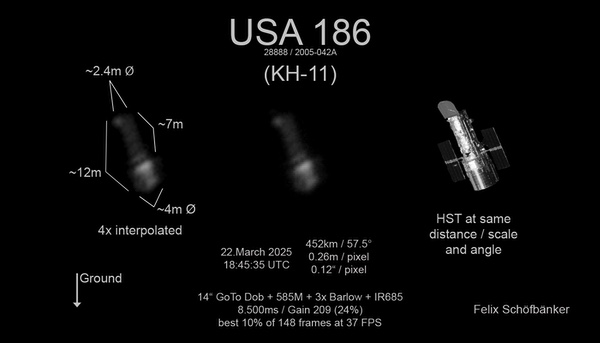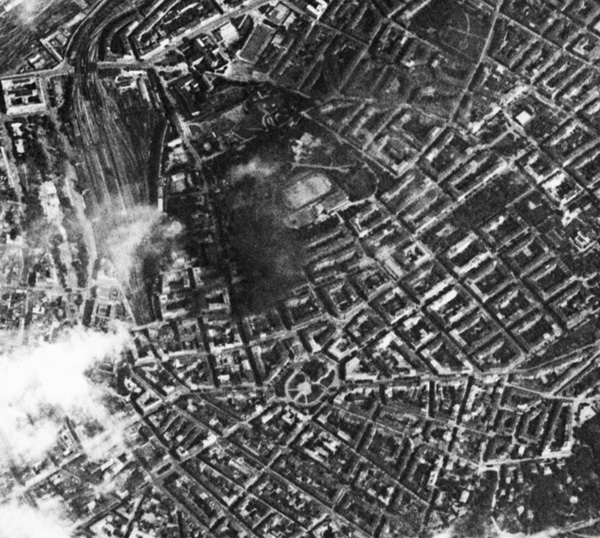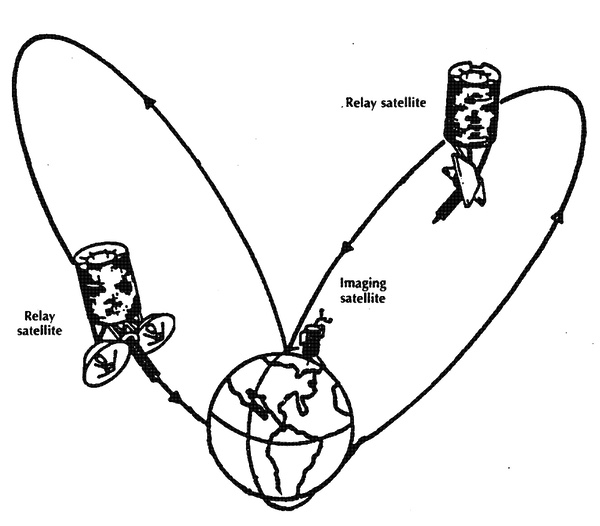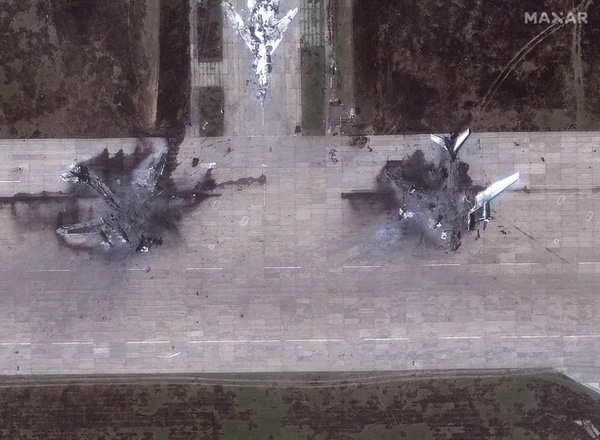The long road to near-real-time satellite reconnaissance: a chronologyby Dwayne A. Day
|
| This is only a preliminary chronology and certainly can be expanded, but it represents a good overview of the declassified history of the development of near-real-time reconnaissance in the United States. |
In 2021, the NRO declassified thousands of pages of documents on the decisions leading up to the development of the KENNEN. Most of the documents covered the period 1969–1971, with very little data on the technological details of the satellites launched, but substantial information about the decisions leading to their development. One of the documents NRO released was a chronology of key events in the 1960s and 1970s up to the initial operations of the KENNEN. That document forms the basis of the annotated chronology that follows, with additional explanations of terms and people involved as appropriate.
The key organizations involved in the development of near-real-time reconnaissance satellites were the National Reconnaissance Office, the CIA’s Office of Special Projects (which was also a sub-component of the NRO known as Program B and located at CIA Headquarters outside of Washington), and the Secretary of the Air Force Special Projects office, SAFSP (also a sub-component of the NRO known as Program A and located in Los Angeles.) The CIA office was much more independent of the NRO than was SAFSP, and a fierce rivalry existed between the CIA and the NRO leadership and SAFSP for much of the 1960s and later. Key companies included Lockheed, which built the spacecraft; Eastman-Kodak, which made the optical system; and General Electric, which was involved in systems integration as well as ground processing.
This is only a preliminary chronology and certainly can be expanded, but it represents a good overview of the declassified history of the development of near-real-time reconnaissance in the United States, one of the most powerful tools in the intelligence community’s toolbox.
 Image taken from the ground of an American near-real-time reconnaissance satellite launched in 2005 and still operational twenty years later. This is a descendant of the KH-11 KENNEN and is approximately the size of the Hubble Space Telescope. (credit: Felix Schöfbänker) |
The pre-Sputnik era
1946: Project RAND conducts a study of technology needed to orbit a satellite.
1951: The RAND Corporation conducts a study of a satellite using TV-like pictures from space and concludes that the technology is currently not available.
1954: RAND conducts the “FEED BACK” study of a reconnaissance satellite, a much more detailed evaluation of how to obtain near-real-time satellite reconnaissance.
1956: Lockheed is awarded the “Pied Piper” contract to develop a reconnaissance satellite. But very little money is allocated to the project. This becomes Weapons System 117L, the overall designation for the reconnaissance satellite program.
1957: President Eisenhower authorizes building of an imaging satellite.
1957: Work begins on SAMOS (often spelled Samos), as part of WS-117L, a very ambitious Air Force constellation of reconnaissance satellites. SAMOS developed film onboard the satellite and scanned it, transmitting the imagery to ground.
Early 1958: President Eisenhower approves the CORONA program to develop a reconnaissance satellite using film-return technology. The advantage of film-return is that a satellite can take many more photos during a short period of time than a film-scanning satellite: thousands rather than a few hundred. The downside is that it takes several days to return the exposed film, develop it, and deliver it to intelligence analysts in Washington.
1960–1965
August 1960: The first successful CORONA reconnaissance satellite mission returns film to Earth. Soon after, the SAMOS film-scanning program is curtailed, although SAMOS continues as a film-return program for several years.
1962(?): CIA founded the Development Projects Division (DDP). It was renamed the Office of Special Activities (OSA) in 1962.
April 1963: United States Intelligence Board (USIB) study on reducing satellite vulnerability recommends near-real-time tasking and readout. CIA/OSA begins study of a covert satellite.
Summer 1963: The GAMBIT high-resolution reconnaissance satellite enters service. It also uses film-return technology and is complimentary to CORONA. CORONA scans large areas to identify targets and new construction, whereas GAMBIT provides more detailed photographs of particular targets of interest.
November 1963: An internal CIA study concludes that time between collection and analysis is critical to indications and warning intelligence.
June 1964: CIA’s Office of Special Activities reports to the Director of the National Reconnaissance Office on the desirability of a near-real-time satellite.
July 1964: The CIA begins the ZOSTER study to investigate various near-real-time associated technologies. Four contracts let:
- reuseable photo-sensitive material
- vidicon tube
- video-transmitted photo simulation
- guidance system
March 1965: ZOSTER produced few conclusions. Reduced to a development planning exercise and assigned to Les Dirks' Design and Analysis Division.
October 1965: The CIA’s Office of Special Projects (OSP) is founded. The Office of Special Activities is transitioned into aircraft operations only (U-2 and A-12 OXCART).
December 1965: Office of Special Projects study begun to pursue near-real-time possibilities.
Late 1965: A contractor is given contracts to develop photo-sensitive elements: a solid-state device.
1965 and 1966: Parallel efforts underway:
- CIA – near-real-time using new technology
- Air Force – near-real-time using GAMBIT, a system known as Film Read-Out GAMBIT, or FROG.
1966–1967
15 September 1966: The Secretary of the Air Force Special Projects office (SAFSP), NRO’s West Coast office, briefed the Committee on Overhead Reconnaissance (COMOR) on FROG. FROG would use the latest version of the GAMBIT optics system, which entered service in 1966, and an updated version of the film-scanning technology originally developed for SAMOS. FROG’s primary limitation would be its lifetime on orbit. (See: “FROG: The Film Read Out GAMBIT Program,” The Space Review, February 7, 2022.)
22–23 September 1966: Office of Special Projects briefed COMOR on ZAMAN. ZAMAN was the new code word, replacing ZOSTER.
23 November 1966: The NRO’s Executive Committee (EXCOM) curtailed level of effort on FROG. (EXCOM consists of senior CIA and DoD personnel and is the equivalent of a board of directors for the NRO director.)
November 1966–August 1967: The Tidwell study on FROG vs. near-real-time, directed by Director of Central Intelligence Richard Helms.
June 1967: OSP included an Advanced Systems Branch, made up of Les Dirks and Norbert Crookston.
June 1967: Thomas Appleberry joined OSP.
August 1967: ZAMAN created in OSP to develop various technologies to the point where a specific system design could be initiated. Two years funding was provided. Frank Eliot and Thomas Appleberry joined Advanced Systems Branch.
 Smoke in downtown Prague after the Soviet invasion in August 1968, photographed by an American reconnaissance satellite. A pre-invasion photograph showed forces preparing to enter Czechoslovakia, but the film was inside the satellite and not returned until after the invasion. (credit: via Harry Stranger) |
1968–1969
14 February 1968: DCI Helms sent Tidwell Study to NRO for comment.
15 May 1968: “Application of Electro-Optical Technology to Satellite Reconnaissance” report published by the CIA’s Office of Special Projects. This was often referred to as Les Dirks’ “Blue Book.” It was the most comprehensive report on the subject up to that time.
May 1968: Intelligence advisor Edwin “Din” Land proposes a full-speed effort on electro-optical imaging. Land was the founder and CEO of Polaroid and very highly regarded as an advisor. He was the most strident, and important, advocate for electro-optical imaging technology, and opposed film-readout technology.
20–21 August 1968: Soviet forces invade Czechoslovakia, catching the United States intelligence community by surprise. The invading units had maintained excellent electronic security, avoiding detection. A CORONA satellite had imaged the forces preparing for invasion, but did not return the film until after the invasion. This event highlighted the value of near-real-time reconnaissance.
November 1968: NRO’s EXCOM gives approval to ZAMAN for near-real-time development.
18 December 1968: The Land Panel is briefed by Frank Eliot, CIA’s Office of Special Projects, on solid-state technology. The panel endorses it as the most promising of the technologies under study.
January 1969: Technology development on relay satellite began. This became known as the Satellite Data System, or SDS. (See: “Spinning in the black: The Satellite Data System and real-time reconnaissance,” The Space Review, May 19, 2025.)
1969: CIA conducts a study on the impact of a near-real-time system on intelligence production.
March 1969: NRO responded negatively to Tidwell study.
June 1969: Director of NRO John McLucas sends the United States Intelligence Board a message favorable to the CIA’s near-real-time work.
January–June 1969: Roland Inlow, chair of the Committee on Imagery Requirements and Exploitation (COMIREX), conducts a study on effects on the user community and the National Photographic Interpretation Center of a near-real-time system.
15 June 1969: The Manned Orbiting Laboratory (MOL) and its DORIAN optical system are canceled. DORIAN was being developed by Eastman-Kodak, giving the company substantial experience in large optics development.
July 1969: The United States Intelligence Board approved the requirement for a near-real-time system.
1 August 1969: Photo Systems Division is formed in CIA’s Office of Special Projects, to merge CORONA and HEXAGON personnel.
August/September 1969: Project financing is revamped: money is authorized to pursue solid-state effort with no system-level design work authorized.
November 1969–January 1970: Fubini Panel eventually threw cold water on near-real-time reconnaissance. Eugene Fubini was a senior intelligence advisor to the government who had served as Assistant Secretary of Defense in the Kennedy and Johnson administrations and was the chief scientist at IBM in the late 1960s.
 Declassified sketch showing how a low Earth orbiting satellite relays images via Satellite Data System relay satellites in very high orbits. (credit: NRO) |
1970–1971
14 February 1970: Fubini Panel report cites serious technical problems and uncertainties about solid-state devices.
27 February 1970: CIA official Les Dirks rebuts Fubini Panel with support from Richard Garwin, a Fubini Panel member. Garwin was a highly regarded intelligence and defense advisor, and the designer of the first American hydrogen bomb. He also had substantial knowledge about solid-state technology.
18 March 1970: Joint meeting of Fubini and Land Panels, with Garwin chairing. This results in a more favorable outlook on electro-optical imaging.
April 1970: Program Office formed in CIA’s Photo Systems Division in the Office of Special Projects.
Late July 1970: ZAMAN becomes a separate program in OSP, with Charles Roth as Project Director. Known internally as the “EOI Program.”
September 1970: System definition request for proposals is issued.
October 1970: Completed testing of imaging system to relay system antenna. This was a key milestone because the imaging system would use a very high frequency transmitter to send its images to the relay satellite. That frequency did not penetrate Earth’s atmosphere and could not be received on the ground, meaning that the Soviet Union could not detect the satellite transmitting while overhead. The relay satellite would convert the signal to a different frequency for beaming down to a ground station in the United States.
November 1970: Contract Review Committee begins looking at system concepts.
9 December 1970: The NRO’s EXCOM is still not satisfied, put off considering system development until January 1971.
January 1971: OSP asked for new bids; program divided into five segments: relay, imaging system, the operations facility (responsible for scheduling, tasking, command and control), processing facility (later split into the digital processing facility and the photo processing facility), and the systems integrator. The systems integrator ensured a consistent set of program requirements, development and maintenance of interface control documents, and that the contract deliverables met the requirements. Hughes was awarded the relay satellite contract and Lockheed the spacecraft contract, with Eastman-Kodak responsible for the optical system. General Electric was awarded the systems integration contract as well as the operations facility. GE also may have been responsible for the ground receiving system, although other contracts may have gone to E-Systems and BDM Corporation.
15 January 1971: Memo from Secretary of State William Rogers to DCI Helms on the benefits of FROG over EOI.
Spring 1971: United States Intelligence Board examines alternatives to ZAMAN because of concern over the time it would take to achieve initial operating capability (late 1975).
Spring 1971: A still-classified effort was created after a Defense Intelligence Agency simulation cast doubt on area coverage capability in frame mode during crisis.
22 April 1971: Memo from Office of Management and Budget director George Shultz to David Packard, which requests near-real-time reconnaissance system be flown in Nixon’s last term.
23 April 1971: The NRO Executive Committee considers FROG. FROG is approved for development.
Summer 1971: Edward E. David memo to President. David was the presidential science advisor. The memo gave options to President Nixon and let him decide.
Summer 1971: EXCOM changed directions, decided to develop both FROG and ZAMAN with primary funding to FROG.
June 1971: Carl Duckett lobbies to have FROG decision overturned.
June 1971: Duckett meets with Senator Allen J. Ellender and William Woodruff. Ellender was concerned about the high costs of intelligence systems.
June 1971: First HEXAGON satellite is launched. HEXAGON is the much more powerful replacement for CORONA. It uses film-return technology.
13 July 1971: Memo from Director Office of Special Projects to Director of the NRO on alternative EOI configurations which could ultimately replace GAMBIT and HEXAGON.
9 August 1971: Memo from DCI Helms to President Nixon, urging that EOI be built instead of FROG and other quick reaction reconnaissance systems that were then under consideration.
17 Aug 1971: Memo from Secretary of Defense Melvin Laird to Nixon on EXCOM decision to fund EOI, noting disagreements between Packard, Helms, and David.
1971: Land Panel Report, EOI vs FROG.
Mid-1971: John Hicks replaced Art Lundahl as Director of NPIC.
1971: Kerr Special Study Group.
Late August 1971: Sidney Drell and Dick Garwin gave a secret briefing to Henry Kissinger on desirability of building ZAMAN.
September 1971: Kissinger letter giving go-ahead to ZAMAN and cancelling FROG. (See: “Intersections in real time: the decision to build the KH-11 KENNEN reconnaissance satellite (part 2),” The Space Review, September 16, 2019.)
30 September 1971: EXCOM stated that Kissinger intended to limit spending on EOI, with first launch in 1976.
November 1971: Relay satellite authorized by DNRO and assigned to Air Force for development. Work began in July 1972.
Late 1971: Kodak is chosen as prime contractor for optics. Lockheed was selected to build the satellite. Other companies were responsible for guidance, command and control, antennas and recorders.
 The launch of the first Satellite Data System relay satellite in June 1976. This satellite relayed images from the first KH-11 reconnaissance satellite launched later in the year. (credit: Peter Hunter Collection) |
1972–1975
January 1972: ZAMAN is renamed KENNEN. “Kennen” is an old English term (also German) meaning “to know.”
April 1972: NRO approved procurement of the relay satellite for KENNEN.
1972: Ray Cline leads a special study group to help the CIA prepare for the KENNEN. The group includes Richard Kerr and Roland Inlow.
June 1972: Hughes Aircraft gets contract for relay satellites 1–3.
September 1972: HEXAGON is transferred to SAFSP, the NRO’s West Coast office, primarily so that ZAMAN could be retained entirely within CIA.
Late 1972: The area search requirement is given to ZAMAN at instigation of Edward David.
20 April 1973: CIA’s Office of Special Projects becomes OD&E (Office of Development and Engineering).
1974: The CIA’s Office of Special Activities is disbanded and its U-2 aircraft are transferred to the Air Force.
1974: Imaging systems mix study, led up to summer 1974. EXCOM decision for the 1976–1980 timeframe.
September 1975: R.P. Hazzard became Program Director, vice Charles Roth.
Late 1975: A still-classified effort was terminated by DNRO. Continued in Program B (CIA) at a very low level in 1976 and 1977.
 Launch of the second KH-11 KENNEN near-real-time reconnaissance satellite in June 1978. The KENNEN provided the ability to send pictures from the other side of the globe back to Washington within minutes, revolutionizing intelligence collection. (credit: Peter Hunter Collection) |
1976–1986
February 1976: The first relay satellite completed system test.
June 1976: The first relay satellite is launched.
August 1976: The second relay satellite is launched.
19 December 1976: The first KENNEN is launched from Vandenberg Air Force Base.
21 December 1976: The first imagery satellite to relay-satellite acquisition.
20 January 1977: The first KH-11 KENNEN satellite is declared operational.
14 June 1978: The second KENNEN is launched from Vandenberg Air Force Base.
17 April 1984: The last GAMBIT satellite is launched. (See: “GAMBIT vs KENNEN: The persistence of film reconnaissance in the digital age,” The Space Review, April 8, 2024.)
18 April 1986: The last HEXAGON satellite explodes above its launch pad at Vandenberg Air Force Base. The era of film-return technology is over. (See “Above Top Secret: the last flight of the Big Bird,” The Space Review, February 18, 2019.)
Next year is the 50th anniversary of the first launch of both the Satellite Data System relay satellites and the KH-11 KENNEN. With any luck, the NRO will declassify more information about these revolutionary intelligence collection systems.
Note: we are now moderating comments. There will be a delay in posting comments and no guarantee that all submitted comments will be posted.
